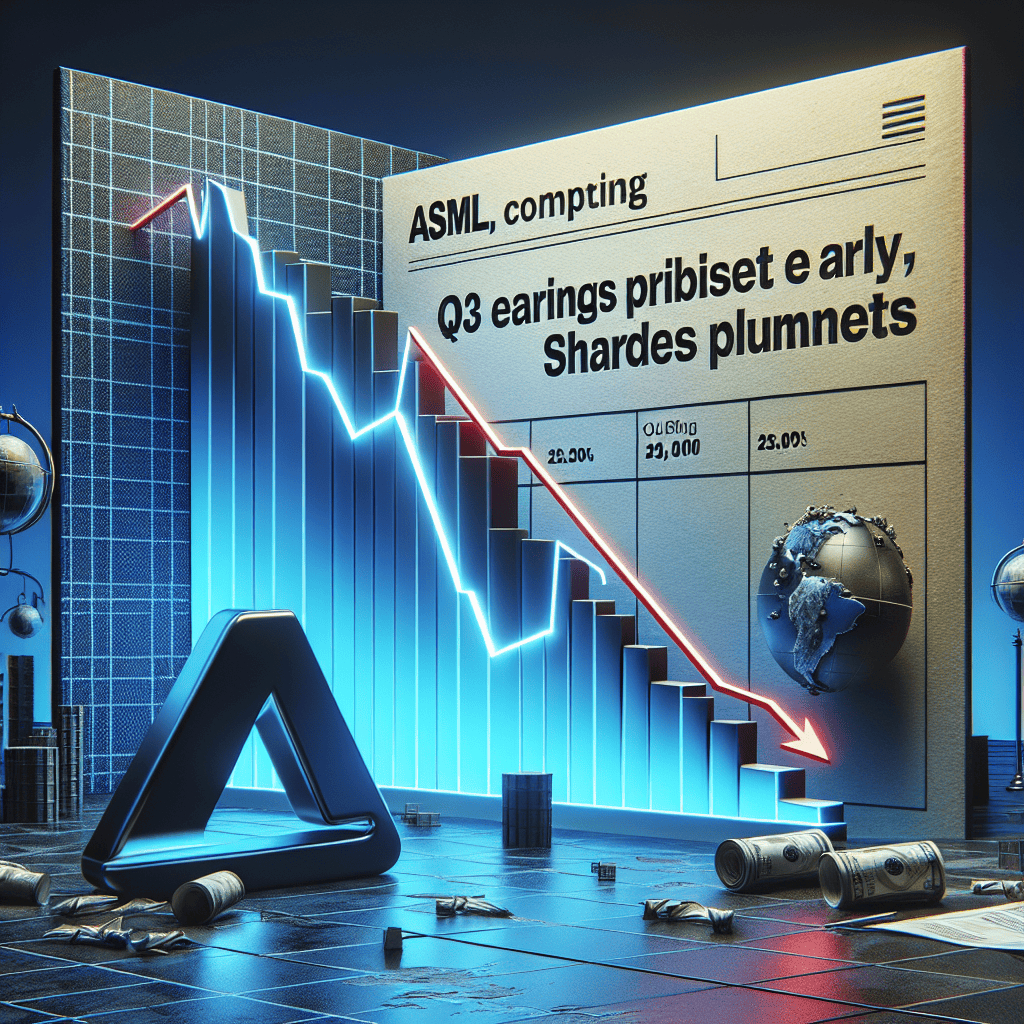“ASML’s Early Q3 Forecast Cuts Trigger Share Slide: Navigating Uncertain Tech Waters”
Introduction
ASML Holding NV, a leading supplier in the semiconductor industry, recently announced a downward revision of its sales forecasts for the third quarter, leading to a significant drop in its share prices. The company’s early release of its Q3 earnings report highlighted challenges in the semiconductor market, including supply chain disruptions and fluctuating demand, which have impacted its financial outlook. This unexpected adjustment has raised concerns among investors, resulting in a sharp decline in ASML’s stock value as the market reacts to the revised projections.
Impact Of ASML’s Sales Forecast Cut On The Semiconductor Industry
ASML Holding NV, a pivotal player in the semiconductor industry, recently made headlines with the early release of its third-quarter earnings report, which included a significant cut in its sales forecasts. This unexpected announcement sent ripples through the financial markets, causing a notable decline in ASML’s share prices. The ramifications of this development extend beyond the company’s immediate financial health, as it holds substantial implications for the broader semiconductor industry.
ASML, renowned for its advanced lithography machines essential for semiconductor manufacturing, plays a critical role in the global supply chain. Consequently, any fluctuations in its financial outlook can have a cascading effect on the entire industry. The company’s decision to lower its sales forecasts is primarily attributed to a combination of factors, including a slowdown in demand from key markets and ongoing geopolitical tensions that have disrupted supply chains. These challenges have compelled ASML to reassess its growth projections, leading to a more cautious outlook for the coming quarters.
The semiconductor industry, already grappling with a myriad of challenges, is likely to feel the impact of ASML’s revised forecasts. For one, the reduced sales expectations may signal a broader slowdown in the demand for semiconductors, which could affect manufacturers and suppliers across the globe. This is particularly concerning given the industry’s recent struggles with supply chain disruptions and component shortages, which have already hindered production and innovation.
Moreover, ASML’s announcement may prompt other companies within the semiconductor sector to reevaluate their own forecasts and strategies. As a leader in the industry, ASML’s actions often set a precedent, influencing the decisions of other firms. This could lead to a more conservative approach across the board, with companies potentially scaling back on investments and expansion plans. Such a shift could have long-term implications for technological advancement and competitiveness within the sector.
In addition to affecting individual companies, ASML’s sales forecast cut may also have broader economic implications. The semiconductor industry is a key driver of technological innovation and economic growth, powering everything from consumer electronics to advanced computing systems. A slowdown in this sector could have a ripple effect on various industries that rely on semiconductors, potentially stalling progress in areas such as artificial intelligence, telecommunications, and automotive technology.
Furthermore, the geopolitical factors contributing to ASML’s revised forecasts cannot be overlooked. Trade tensions and regulatory challenges have created an uncertain environment for semiconductor companies, complicating their ability to operate efficiently and predict future demand. As these geopolitical issues persist, they may continue to exert pressure on the industry, necessitating strategic adjustments and increased resilience.
In conclusion, ASML’s decision to cut its sales forecasts in its third-quarter earnings report has sent shockwaves through the semiconductor industry. The implications of this move are far-reaching, affecting not only ASML’s financial standing but also the broader industry’s growth prospects and strategic direction. As companies navigate this challenging landscape, they must remain agile and adaptable, finding ways to mitigate risks and capitalize on emerging opportunities. Ultimately, the industry’s ability to weather these challenges will be crucial in determining its future trajectory and its continued role as a catalyst for technological innovation and economic progress.
Analyzing The Reasons Behind ASML’s Q3 Earnings Report
ASML, a leading player in the semiconductor industry, recently released its third-quarter earnings report earlier than anticipated, revealing a downward revision in its sales forecasts. This unexpected announcement sent ripples through the financial markets, causing a significant drop in the company’s share price. To understand the implications of this development, it is essential to delve into the factors that contributed to ASML’s revised outlook and the broader context within which these changes occurred.
Firstly, it is important to consider the global semiconductor market’s current state, which has been characterized by a series of fluctuations over the past few years. The industry has faced numerous challenges, including supply chain disruptions, geopolitical tensions, and fluctuating demand patterns. These factors have collectively created an environment of uncertainty, making it difficult for companies like ASML to maintain stable growth projections. Consequently, ASML’s decision to cut its sales forecasts can be seen as a response to these broader market dynamics.
Moreover, ASML’s position as a supplier of advanced lithography equipment, which is crucial for the production of cutting-edge semiconductors, means that its fortunes are closely tied to the investment cycles of major chip manufacturers. Recently, there has been a noticeable shift in these investment patterns, with some companies delaying or scaling back their capital expenditures due to economic uncertainties and changing consumer demand. This shift has inevitably impacted ASML’s order book, prompting the company to adjust its sales expectations accordingly.
In addition to these external factors, internal challenges have also played a role in ASML’s revised forecasts. The company has been navigating the complexities of ramping up production for its latest generation of extreme ultraviolet (EUV) lithography machines. While these machines represent a significant technological advancement, their production and deployment involve intricate processes that can be susceptible to delays and cost overruns. Any hiccups in this area can have a direct impact on ASML’s ability to meet its sales targets, further necessitating a reassessment of its financial outlook.
Furthermore, the competitive landscape in the semiconductor equipment sector is evolving rapidly, with new entrants and existing players vying for market share. This increased competition can exert pressure on ASML’s pricing strategies and profit margins, compelling the company to adopt a more conservative approach in its financial projections. By revising its sales forecasts, ASML is likely positioning itself to navigate these competitive pressures more effectively, ensuring that it remains agile and responsive to market changes.
Despite the immediate negative reaction from investors, it is crucial to recognize that ASML’s long-term prospects remain robust. The company’s technological leadership and strategic partnerships with key industry players provide a solid foundation for future growth. Moreover, the ongoing digital transformation across various sectors continues to drive demand for advanced semiconductors, offering significant opportunities for ASML in the years to come.
In conclusion, ASML’s decision to cut its sales forecasts in its third-quarter earnings report reflects a confluence of external and internal factors that have reshaped the company’s near-term outlook. While this development has understandably caused concern among investors, it is essential to view it within the broader context of the semiconductor industry’s evolving landscape. By addressing these challenges head-on and maintaining its focus on innovation and strategic partnerships, ASML is well-positioned to navigate the current uncertainties and capitalize on future growth opportunities.
How ASML’s Share Price Drop Affects Investors
ASML Holding NV, a pivotal player in the semiconductor industry, recently experienced a significant drop in its share price following the early release of its third-quarter earnings report, which included a downward revision of its sales forecasts. This unexpected development has sent ripples through the investment community, prompting investors to reassess their positions and strategies concerning ASML’s stock. The company’s revised sales forecast, which reflects a more cautious outlook for the coming quarters, has raised concerns about the broader implications for the semiconductor sector and the global technology supply chain.
The immediate impact of ASML’s announcement was a sharp decline in its share price, a reaction that underscores the sensitivity of the market to any signs of slowing growth in the semiconductor industry. Investors, who had previously been buoyed by the company’s strong performance and optimistic projections, are now faced with the challenge of recalibrating their expectations. This recalibration is not merely a reaction to ASML’s revised forecasts but also a reflection of broader market dynamics, including potential shifts in demand for semiconductor equipment and the ongoing geopolitical tensions that could affect global supply chains.
For investors, the drop in ASML’s share price presents both challenges and opportunities. On one hand, the decline may lead to short-term losses for those who had invested heavily in the company’s stock, banking on its continued growth trajectory. On the other hand, the lower share price could present a buying opportunity for investors who believe in ASML’s long-term potential and are willing to weather the current volatility. This dichotomy highlights the importance of a nuanced investment strategy that takes into account both immediate market reactions and long-term industry trends.
Moreover, ASML’s situation serves as a reminder of the inherent risks associated with investing in the technology sector, particularly in companies that are heavily reliant on cyclical industries like semiconductors. The semiconductor industry is known for its rapid technological advancements and fluctuating demand cycles, which can lead to significant volatility in the stock prices of companies operating within this space. As such, investors must remain vigilant and informed, continuously monitoring industry developments and adjusting their portfolios accordingly.
In addition to individual investment strategies, ASML’s revised sales forecasts and subsequent share price drop may also have broader implications for institutional investors and mutual funds with significant holdings in the company. These entities may need to reassess their asset allocations and risk management strategies to mitigate potential losses and capitalize on emerging opportunities. Furthermore, the situation could prompt a reevaluation of investment strategies across the semiconductor sector, as investors seek to identify companies that are better positioned to navigate the current challenges and capitalize on future growth opportunities.
In conclusion, ASML’s recent share price drop following its revised sales forecasts serves as a stark reminder of the volatility inherent in the semiconductor industry and the broader technology sector. For investors, this development underscores the importance of maintaining a balanced and informed approach to investment, one that considers both short-term market dynamics and long-term industry trends. As the situation continues to evolve, investors will need to remain agile, adapting their strategies to navigate the challenges and opportunities that lie ahead.
Future Outlook For ASML After Q3 Earnings Announcement

ASML Holding NV, a pivotal player in the semiconductor industry, recently released its third-quarter earnings report ahead of schedule, revealing a downward revision in its sales forecasts. This unexpected announcement sent ripples through the financial markets, causing a significant drop in the company’s share price. As investors and industry analysts digest this development, the future outlook for ASML becomes a topic of considerable interest and speculation.
The company’s decision to cut its sales forecasts is primarily attributed to a slowdown in demand from key customers, particularly in the memory chip sector. This sector has been experiencing a cyclical downturn, exacerbated by broader economic uncertainties and geopolitical tensions. Consequently, ASML’s revised projections reflect a more cautious approach to navigating these challenges. Despite the immediate negative impact on its stock, ASML remains a dominant force in the semiconductor equipment market, particularly with its cutting-edge extreme ultraviolet (EUV) lithography technology. This technology is crucial for producing the most advanced microchips, and ASML’s near-monopoly in this area provides a strong foundation for long-term growth.
In light of the current situation, ASML’s management has emphasized its commitment to strategic investments in research and development. By continuing to innovate and enhance its product offerings, the company aims to maintain its competitive edge and capture future growth opportunities. Moreover, ASML’s robust order backlog, which extends well into the coming years, offers a degree of stability and confidence in its ability to weather short-term market fluctuations.
Furthermore, the global push towards digital transformation and the increasing demand for advanced technologies such as artificial intelligence, 5G, and the Internet of Things are expected to drive long-term growth in the semiconductor industry. ASML is well-positioned to benefit from these trends, as its technology is integral to the production of the high-performance chips required for these applications. Therefore, while the current sales forecast revision may pose challenges in the near term, the underlying demand drivers for ASML’s products remain strong.
Additionally, ASML’s strategic partnerships with leading semiconductor manufacturers provide a solid framework for future collaboration and innovation. These alliances not only enhance ASML’s market position but also facilitate the development of next-generation technologies that will shape the future of the industry. As these partnerships continue to evolve, they are likely to yield significant benefits for ASML and its stakeholders.
In conclusion, while the recent cut in sales forecasts has undoubtedly impacted ASML’s immediate financial outlook, the company’s long-term prospects remain promising. Its leadership in EUV technology, commitment to innovation, and strategic industry partnerships position ASML favorably to capitalize on the growing demand for advanced semiconductor solutions. As the semiconductor industry continues to evolve, ASML’s ability to adapt and innovate will be crucial in maintaining its leadership position and driving future growth. Investors and industry observers will be closely monitoring ASML’s progress as it navigates the current challenges and seeks to leverage emerging opportunities in the ever-changing technological landscape.
Market Reactions To ASML’s Revised Sales Forecast
ASML Holding NV, a pivotal player in the semiconductor industry, recently made headlines with the early release of its third-quarter earnings report, which included a downward revision of its sales forecasts. This unexpected announcement sent ripples through the financial markets, leading to a significant drop in the company’s share price. Investors and analysts alike are now grappling with the implications of ASML’s revised outlook, as the company plays a crucial role in the global supply chain for advanced microchips.
The Dutch company, renowned for its cutting-edge lithography machines used in the production of semiconductors, has long been considered a bellwether for the tech industry. Therefore, any adjustments to its financial projections are closely scrutinized by market participants. In its latest earnings report, ASML cited a combination of factors contributing to the revised sales forecast, including a slowdown in demand from key customers and broader macroeconomic uncertainties. These elements have collectively dampened the company’s growth prospects for the near term.
One of the primary reasons for the reduced sales forecast is the deceleration in demand from major semiconductor manufacturers. As these companies face their own set of challenges, including inventory adjustments and fluctuating consumer demand, their orders for ASML’s advanced equipment have tapered off. This trend is not isolated to ASML alone but reflects a broader cooling in the semiconductor industry, which had previously experienced a period of rapid expansion driven by the global digital transformation and increased reliance on technology during the pandemic.
Moreover, ASML’s revised outlook is also influenced by macroeconomic factors that have introduced a layer of uncertainty into the market. Geopolitical tensions, particularly those involving key semiconductor-producing regions, have raised concerns about potential disruptions in the supply chain. Additionally, inflationary pressures and rising interest rates have contributed to a more cautious approach by businesses and consumers alike, further impacting demand for technology products and, by extension, the equipment used to manufacture them.
In response to the revised sales forecast, ASML’s shares experienced a sharp decline, reflecting investor apprehension about the company’s future performance. The market reaction underscores the sensitivity of ASML’s stock to changes in its financial outlook, given its significant role in the semiconductor ecosystem. As investors digest the implications of the earnings report, there is a growing focus on how ASML plans to navigate these challenges and what strategies it will employ to mitigate the impact on its business.
Despite the current headwinds, ASML remains optimistic about its long-term prospects. The company continues to invest in research and development to maintain its technological edge and meet the evolving needs of its customers. Furthermore, ASML’s management has emphasized its commitment to enhancing operational efficiencies and exploring new growth opportunities, which could help offset some of the near-term pressures.
In conclusion, ASML’s revised sales forecast has prompted a swift and pronounced reaction in the financial markets, highlighting the interconnectedness of the semiconductor industry and the broader economic landscape. As the company works to address the challenges it faces, stakeholders will be closely monitoring its progress and assessing the potential for recovery. While the immediate outlook may be clouded by uncertainty, ASML’s strategic initiatives and continued innovation could position it well for future growth once market conditions stabilize.
Comparing ASML’s Performance With Competitors In Q3
In the third quarter of the fiscal year, ASML Holding NV, a leading player in the semiconductor equipment industry, faced a significant setback as it revised its sales forecasts downward, leading to a sharp decline in its share prices. This unexpected development has prompted investors and analysts to scrutinize ASML’s performance in comparison to its competitors, as the semiconductor industry continues to navigate a complex landscape marked by fluctuating demand and supply chain challenges. ASML’s early release of its Q3 earnings report revealed a cautious outlook, with the company citing a slowdown in demand from key customers as a primary reason for the revised forecasts. This announcement sent ripples through the market, causing ASML’s shares to plummet as investors reacted to the news. The company’s decision to cut its sales forecasts underscores the broader challenges facing the semiconductor industry, which has been grappling with a cyclical downturn exacerbated by geopolitical tensions and economic uncertainties.
In contrast, some of ASML’s competitors have managed to weather the storm more effectively, demonstrating resilience in the face of adversity. For instance, companies like Applied Materials and Lam Research have reported relatively stable performances in their recent earnings releases. These firms have benefited from diversified product portfolios and strategic investments in emerging technologies, which have helped them mitigate the impact of the current downturn. Moreover, their ability to adapt to changing market dynamics has allowed them to maintain a competitive edge, even as the industry faces headwinds.
One of the key differentiators between ASML and its competitors lies in their respective approaches to innovation and technology development. ASML has long been a pioneer in the field of extreme ultraviolet (EUV) lithography, a cutting-edge technology that is critical for the production of advanced semiconductor chips. While this has positioned ASML as a leader in the high-end segment of the market, it also exposes the company to greater risks, as any fluctuations in demand for EUV technology can have a pronounced impact on its financial performance. In contrast, competitors like Applied Materials have focused on a broader range of technologies, allowing them to capture opportunities across different segments of the semiconductor market.
Furthermore, ASML’s reliance on a few major customers for a significant portion of its revenue has made it more vulnerable to shifts in customer demand. This concentration risk has been highlighted by the recent slowdown, as key customers have scaled back their orders in response to changing market conditions. On the other hand, competitors with a more diversified customer base have been better positioned to absorb such shocks, as they are less dependent on any single customer for their revenue streams.
Despite these challenges, it is important to note that ASML remains a formidable player in the semiconductor industry, with a strong track record of innovation and a robust pipeline of new technologies. The company’s leadership in EUV lithography continues to be a significant competitive advantage, and its ongoing investments in research and development are likely to yield long-term benefits. However, in the short term, ASML will need to navigate the current downturn carefully, balancing its focus on cutting-edge technology with the need to adapt to evolving market conditions.
In conclusion, ASML’s recent sales forecast revision and subsequent share price decline have highlighted the challenges facing the semiconductor industry as a whole. While some competitors have managed to maintain stability through diversification and strategic investments, ASML’s reliance on EUV technology and a concentrated customer base has exposed it to greater risks. As the industry continues to evolve, ASML will need to leverage its strengths while addressing its vulnerabilities to remain competitive in an increasingly dynamic market.
Strategies For ASML To Recover From Q3 Sales Forecast Cut
ASML Holding NV, a pivotal player in the semiconductor industry, recently faced a significant setback as it announced a cut in its sales forecasts for the third quarter. This unexpected development, which was disclosed earlier than anticipated, sent ripples through the financial markets, resulting in a sharp decline in the company’s share prices. As stakeholders grapple with the implications of this announcement, it becomes imperative for ASML to devise strategic measures to navigate this challenging period and restore investor confidence.
To begin with, ASML must undertake a comprehensive analysis of the factors contributing to the revised sales forecasts. By identifying the root causes, whether they stem from supply chain disruptions, shifts in market demand, or geopolitical tensions, the company can develop targeted strategies to mitigate these challenges. This diagnostic approach will not only help in addressing immediate concerns but also in fortifying the company’s resilience against future uncertainties.
In parallel, ASML should consider enhancing its communication strategy with investors and stakeholders. Transparent and timely communication can play a crucial role in managing market perceptions and expectations. By providing clear insights into the reasons behind the forecast cut and outlining a robust recovery plan, ASML can reassure investors of its commitment to long-term growth and stability. Regular updates on progress and any adjustments to the strategy will further reinforce this trust.
Moreover, ASML could explore diversifying its product portfolio to reduce dependency on specific market segments. By investing in research and development, the company can innovate and introduce new technologies that cater to emerging demands in the semiconductor industry. This diversification not only opens up new revenue streams but also positions ASML as a versatile player capable of adapting to evolving market dynamics.
Additionally, strategic partnerships and collaborations could serve as a catalyst for ASML’s recovery. By aligning with other industry leaders, ASML can leverage shared resources and expertise to accelerate innovation and expand its market reach. These alliances can also provide a buffer against market volatility, as they often lead to synergies that enhance operational efficiency and cost-effectiveness.
Furthermore, ASML should focus on optimizing its operational processes to improve efficiency and reduce costs. Streamlining production, enhancing supply chain management, and adopting advanced technologies such as artificial intelligence and automation can significantly boost productivity. These measures not only contribute to cost savings but also enhance the company’s competitive edge in a rapidly evolving industry.
In light of the growing emphasis on sustainability, ASML could also integrate environmental, social, and governance (ESG) considerations into its strategic framework. By committing to sustainable practices, the company can appeal to a broader base of socially conscious investors and consumers. This commitment not only enhances ASML’s brand reputation but also aligns with global trends towards responsible business practices.
In conclusion, while the recent cut in sales forecasts presents a formidable challenge for ASML, it also offers an opportunity for introspection and strategic realignment. By adopting a multifaceted approach that encompasses thorough analysis, transparent communication, diversification, strategic partnerships, operational optimization, and sustainability, ASML can navigate this turbulent period and emerge stronger. As the company implements these strategies, it will be crucial to maintain a focus on innovation and adaptability, ensuring that it remains at the forefront of the semiconductor industry. Through these concerted efforts, ASML can not only recover from its current predicament but also lay a solid foundation for sustained growth and success in the future.
Q&A
1. **What did ASML announce in their Q3 earnings report?**
ASML announced that they were cutting their sales forecasts for the upcoming quarters.
2. **How did the market react to ASML’s announcement?**
Shares of ASML plummeted following the announcement of the reduced sales forecasts.
3. **What reasons did ASML provide for cutting their sales forecasts?**
ASML cited a slowdown in demand from semiconductor manufacturers and potential macroeconomic challenges as reasons for the forecast cut.
4. **What impact did the sales forecast cut have on ASML’s stock price?**
The announcement led to a significant drop in ASML’s stock price as investors reacted to the news.
5. **Did ASML provide any guidance for future quarters?**
Yes, ASML provided revised guidance for future quarters, indicating a more cautious outlook due to the current market conditions.
6. **How did analysts respond to ASML’s revised forecasts?**
Analysts expressed concern over the reduced forecasts, with some adjusting their ratings and price targets for ASML’s stock.
7. **What are the broader implications of ASML’s forecast cut for the semiconductor industry?**
The forecast cut by ASML suggests potential challenges for the semiconductor industry, including reduced capital expenditure by chipmakers and a possible slowdown in technological advancements.
Conclusion
ASML’s decision to cut its sales forecasts in its early Q3 earnings report has led to a significant drop in its share prices. This reaction from the market reflects investor concerns about the company’s future revenue potential and the broader implications for the semiconductor industry. The reduced sales outlook may be attributed to various factors, such as supply chain disruptions, decreased demand, or increased competition. The sharp decline in share value underscores the sensitivity of the market to changes in financial projections and highlights the challenges ASML faces in maintaining its growth trajectory amidst a volatile economic environment.





